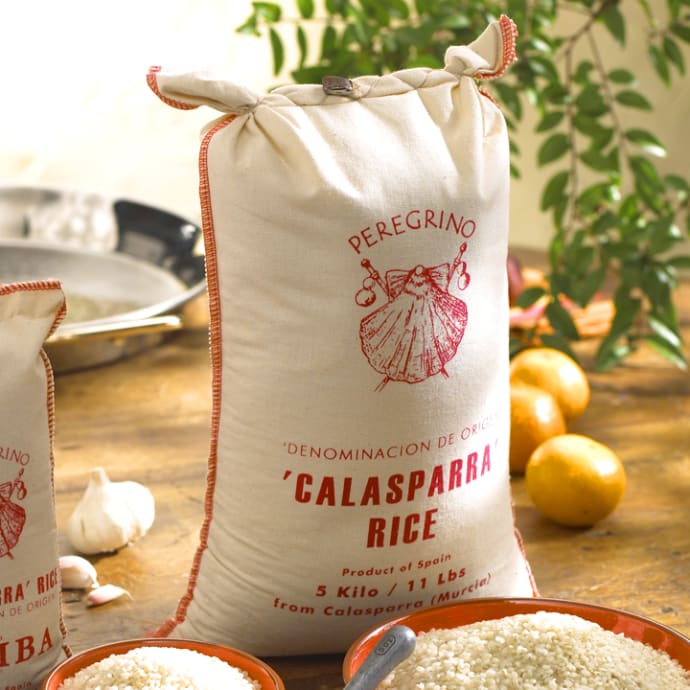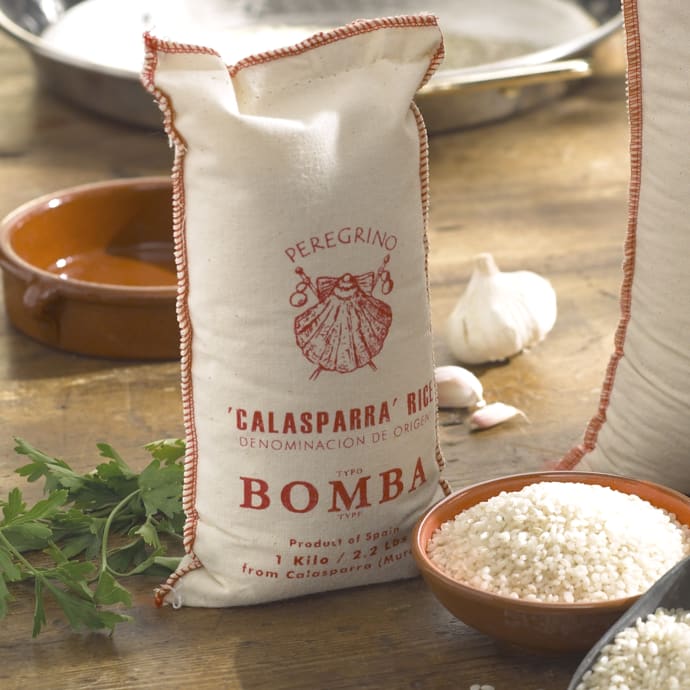
Stuck in a Stew Over Rice
The Washington Post
-
August 2, 2006
It seems that every recipe calls for a different kind of rice: white or brown, long grain or short grain, and so on. I can tell white from brown, but am I supposed to take a ruler with me to the market to measure how long the rice grains are?
Robert L. Wolke
Absolutely. Paella rice must be absorbent enough to soak up the savory broth from the seafood or meat and must cook up to just the right degree of "clumpiness."
In American restaurants, the sins committed daily against this legendary Spanish dish must be overwhelming the check-in clerks at the Hades Hotel. Paella is not just a pile of Uncle Ben's with a bunch of stuff stuck in it. Nothing against old Ben, but his rice (which is parboiled, then dried) is American long grain, and that just won't cut the mostaza in Spain.
Botanically speaking, all rice belongs to only two plant species: Oryza sativa and Oryza glaberrima. But tens of thousands of cultivated varieties (known as cultivars) have been developed and propagated for at least 6,000 years in China and around the world. And they all have properties that best suit them to the indigenous cuisines.
More than anything else, what differs from one rice cultivar to another is the relative proportions of two kinds of starch (rice is 77 to 80 percent starch). The two kinds are amylose, whose molecules are straight chains, and amylopectin, whose molecules are branched and bushy.
Most American rice is rich in amylose, whose straight molecules don't absorb much water, so the grains stay relatively dry and fluffy when cooked. Chinese and Japanese rice, on the other hand, is richer in amylopectin, whose bushy molecules can trap a lot of water. On cooking, the water swells and bursts the starch granules, releasing their gluey contents, and the grains therefore tend to stick together, the better to be picked up with chopsticks or, as in many Asian countries, with the fingers.
What about the lengths of the grains? That's just a rough way of classifying types of rice without going raving mad trying to name them all. Luckily, their sizes and shapes really do correspond more or less to the kinds of starch they contain: Short-grain rices are generally high-amylopectin, absorbent and sticky. If you ever do take a ruler to the supermarket, here are the standard shapes: Long-grain rice is three or more times as long as it is wide. Short-grain rice is less than twice as long as it is wide and is often almost round. In the United States, we recognize a medium-grain size, which is two to three times as long as it is wide.
On a quick trip to my local supermarket, I discovered that all Uncle Ben's rice products are labeled long grain, River Rice products are labeled medium grain, and most of the products whose names end in -Roni don't specify their type of rice at all.
In recent years, several specialty rices have become popular in the United States. Aromatic rices, such as Indian and Pakistani basmati and Thai jasmine, contain more of the fragrant chemical 2-acetyl-1-pyrroline than usual and have a nutty, popcorn-like flavor. Italian arborio rice is high in amylopectin and perfect for making risotto because it can absorb three times its own volume of flavorful stock or broth, becoming creamy in the process. In a pinch, it will make a pretty good paella.
I recently had the pleasure of visiting the Albufera rice-growing region just south of Valencia, Spain, the home of that country's most famous dish, paella valenciana. From Santos Ruiz Álvarez, a personable young agricultural engineer who heads the council Denominacion de Origen Arroz de Valencia, which regulates and controls the quality of Valencian rice, I learned more about rice than I could shake a banderilla at. This is not a recipe column, but I can't resist pointing out a few essential qualities of a paella-worthy rice.
A medium- short-grain rice is indispensable. The three main varieties cultivated in Valencia are Bahia, Senia and Bomba. In the center of each of these grains is a perla (pearl), a dense nucleus of concentrated starch that imparts a certain toothy substance to the cooked rice. Another quite acceptable rice for paella is Calasparra, grown in the mountains of Murcia, southwest of Valencia.
Álvarez says he prefers Senia because it absorbs more of the flavorful broth, but he admits that when cooking for company he uses Bomba because it is more tolerant of being overlooked and overcooked during the sherry and cava sipping that inevitably precedes the convivial meal. In Spain, paella is often cooked by the men in the family on Sundays, over an open fire if possible. And a good time is had by all.
Imported paella rice is available from La Tienda.
Further Adventures in Kitchen Science" (W.W. Norton, 2005). He can be reached atwolke@pitt.edu.
© 2007 The Washington Post Company
Robert L. Wolke
Absolutely. Paella rice must be absorbent enough to soak up the savory broth from the seafood or meat and must cook up to just the right degree of "clumpiness."
In American restaurants, the sins committed daily against this legendary Spanish dish must be overwhelming the check-in clerks at the Hades Hotel. Paella is not just a pile of Uncle Ben's with a bunch of stuff stuck in it. Nothing against old Ben, but his rice (which is parboiled, then dried) is American long grain, and that just won't cut the mostaza in Spain.
Botanically speaking, all rice belongs to only two plant species: Oryza sativa and Oryza glaberrima. But tens of thousands of cultivated varieties (known as cultivars) have been developed and propagated for at least 6,000 years in China and around the world. And they all have properties that best suit them to the indigenous cuisines.
More than anything else, what differs from one rice cultivar to another is the relative proportions of two kinds of starch (rice is 77 to 80 percent starch). The two kinds are amylose, whose molecules are straight chains, and amylopectin, whose molecules are branched and bushy.
Most American rice is rich in amylose, whose straight molecules don't absorb much water, so the grains stay relatively dry and fluffy when cooked. Chinese and Japanese rice, on the other hand, is richer in amylopectin, whose bushy molecules can trap a lot of water. On cooking, the water swells and bursts the starch granules, releasing their gluey contents, and the grains therefore tend to stick together, the better to be picked up with chopsticks or, as in many Asian countries, with the fingers.
What about the lengths of the grains? That's just a rough way of classifying types of rice without going raving mad trying to name them all. Luckily, their sizes and shapes really do correspond more or less to the kinds of starch they contain: Short-grain rices are generally high-amylopectin, absorbent and sticky. If you ever do take a ruler to the supermarket, here are the standard shapes: Long-grain rice is three or more times as long as it is wide. Short-grain rice is less than twice as long as it is wide and is often almost round. In the United States, we recognize a medium-grain size, which is two to three times as long as it is wide.
On a quick trip to my local supermarket, I discovered that all Uncle Ben's rice products are labeled long grain, River Rice products are labeled medium grain, and most of the products whose names end in -Roni don't specify their type of rice at all.
In recent years, several specialty rices have become popular in the United States. Aromatic rices, such as Indian and Pakistani basmati and Thai jasmine, contain more of the fragrant chemical 2-acetyl-1-pyrroline than usual and have a nutty, popcorn-like flavor. Italian arborio rice is high in amylopectin and perfect for making risotto because it can absorb three times its own volume of flavorful stock or broth, becoming creamy in the process. In a pinch, it will make a pretty good paella.
I recently had the pleasure of visiting the Albufera rice-growing region just south of Valencia, Spain, the home of that country's most famous dish, paella valenciana. From Santos Ruiz Álvarez, a personable young agricultural engineer who heads the council Denominacion de Origen Arroz de Valencia, which regulates and controls the quality of Valencian rice, I learned more about rice than I could shake a banderilla at. This is not a recipe column, but I can't resist pointing out a few essential qualities of a paella-worthy rice.
A medium- short-grain rice is indispensable. The three main varieties cultivated in Valencia are Bahia, Senia and Bomba. In the center of each of these grains is a perla (pearl), a dense nucleus of concentrated starch that imparts a certain toothy substance to the cooked rice. Another quite acceptable rice for paella is Calasparra, grown in the mountains of Murcia, southwest of Valencia.
Álvarez says he prefers Senia because it absorbs more of the flavorful broth, but he admits that when cooking for company he uses Bomba because it is more tolerant of being overlooked and overcooked during the sherry and cava sipping that inevitably precedes the convivial meal. In Spain, paella is often cooked by the men in the family on Sundays, over an open fire if possible. And a good time is had by all.
Imported paella rice is available from La Tienda.
Further Adventures in Kitchen Science" (W.W. Norton, 2005). He can be reached atwolke@pitt.edu.
© 2007 The Washington Post Company





